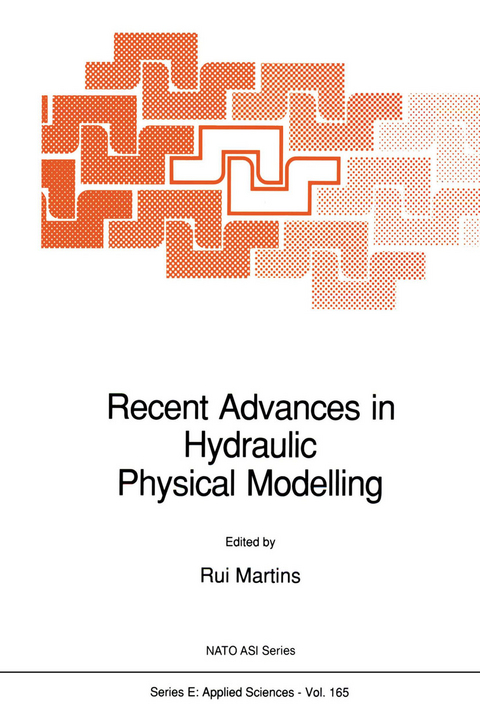
Recent Advances in Hydraulic Physical Modelling
Springer (Verlag)
978-94-010-7555-8 (ISBN)
The growing use of mathematical models in hydraulics has not made physical models obsolete. They keep pace with mathematical models and in some cases make progress in conjunction with them Physical models continue to be developed: more precise use of similitude criteria, better knowledge of scale effects, new and more complex types of model,use of various artifices, more ade- quate instrumentation, automation of the operation of model- all these pOint to that development. What was needed was to make a survey of the situation, and this was the principal aim of the NATO Advanced Study Institute on Recent Advances in Hydraulic Physical Modelling, which took place on the premises of the Laborat6rio Nacional de Engenharia Civil (LNEC) in Lisbon, Portugal, from 4th to 15th July 1988, and of which this book is one of the main outputs. It is divided into 11 chapters, corresponding to 28 lectures that cover five areas: fundamentals of physical modelling, river models, hydraulics of structures, maritime hvdraulics and densi ty models. -- Hodelling is obviously dependent on the knowledge of the phe- nomena that are being modelled.
This book is therefore also a book on hydraulic engineering in general and not only on phv- sical, modelling. The text also refers to mathematical modelling, experimental methods in hydraulics and observation of nature and prototypes.
1 Fundamentals of Hydraulic Physical Modelling.- 1. Introduction.- 2. Principles of the Theory of Dimensions.- 3. Principles of the Theory of Similarity.- 4. Hydraulic Models.- 5. Further Approaches to Hydraulic Model Design.- 2 River Models.- 1. Non Maritime Models with Fixed Bed.- 2. Sediment Transport in Rivers.- 3. River Models with Movable Bed.- 3 Models for Study of the Dynamic Behaviour of Structures in Flow and Waves.- 1. Introduction in the Held of Hydro-Elasticity.- 2. The Single Resonator in a Flow Field.- 3. Response Calculations at Random Excitation.- 4. Introduction to Added Mass, Added Damping, Added Rigidity and Self-Excitation.- 5. Models with Elastic Similarity for the Investigation of Hydraulic Structures.- 6. The Use (Applicability and Limitations) of Physical Models in Vibration Research.- 7. Interpretation of Results.- 8. Cavitation Research.- 9. Strategy for Vibrations-Free Design of Larger Gate Structures.- 10. New Developments in the Field of Modelling Hydro-Elasticity.- 4 Models for Study of the Hydrodynamic Actions on Hydraulic Structures.- 1. Introduction.- 2. Hydrodynamic Actions on Stilling Basins.- 3. Dynamic Analysis.- 4. Hydraulic Modelling of Hydrodynamic Actions.- 5 Density Models.- 1. Introduction.- 2. Modelling Principles.- 3. Scale and Boundary Effects.- 4. Limitations.- 5. Model Specifications.- 6. Applications.- 7. Case Studies.- 6 Tidal Models.- 1. Introduction.- 2. Model Laws.- 3. Boundary Conditions.- 4. Operation of Tidal Models.- 5. Instrumentation. Data Acquisition and Model Control.- 6. Case Studies.- 7 Hybrid Modelling as Applied to Hydrodynamic Research and Testing.- 1. Introduction.- 2. The Design of the Demonstration Hybrid Model.- 3. The Construction of the Demonstration Hybrid Model.- 4. Experimentation with the Hybrid Model.- 5. Other Tidal Control Machines.- 6. Future Plans.- 7. Hybrid Applications.- 8. Future Aspects of Hybrid Modelling and Conclusions.- 8 Wave Grouping and Harbour Design. Safe Underkeel Allowances for Vessels in Restricted Depths.- I.- 1. Introduction.- 2. Real Sea Measurements.- 3. Random Wave Model.- 4. Real Time Set-Down Compensation.- 5. Experimental Results.- 6. Application to a Physical Model.- 7. Conclusions.- II.- 1. Introduction.- 2. Background to the Dover Strait Study.- 3. Acceptable Risk Factor.- 4. Wave Climate in the Dover Strait.- 5. Ship Responses in Waves.- 6. Water Depth Uncertainties.- 7. Vessel Squat.- 8. Calculation of Underkeel Allowances.- 9. Conclusions.- 9 Sea Wave Simulation.- 1. Introduction.- 2. Sea Wave Characterization.- 3. Computer Simulation.- 4. Physical Model Simulation.- 5. Topics on Multidirectional Simulation.- 6. “Deterministic” and “Non-Deterministic” Simulation.- 10 Dynamic Actions on Breakwaters (Rubble-Mound and Caisson/Composite Type Breakwaters).- 1. Rubble-Mound Breakwaters.- 2. Caisson/Composite Breakwaters.- 11 Physical Modelling of Littoral Processes.- 1. Abstract.- 2. Introduction.- 3. Coastal Processes-An Overview.- 4. Modelling Facilities.- 5. Hydrodynamic Physical Models.- 6. Littoral Process Models.- 7. Model Testing Procedures.- 8. Conclusion.- Final Remarks.- Annexes.- Annex 1 — Introductory words.- Annex 2 — Panel sessions/round tables.- Annex 3 — Non-usual hydraulic models.- Annex 4 — Higher order wave generation in laboratory experiments.- Annex 5 — List of participants.
| Reihe/Serie | NATO Science Series E ; 165 |
|---|---|
| Zusatzinfo | XVIII, 627 p. |
| Verlagsort | Dordrecht |
| Sprache | englisch |
| Maße | 155 x 235 mm |
| Themenwelt | Sachbuch/Ratgeber ► Natur / Technik ► Garten |
| Naturwissenschaften ► Geowissenschaften ► Geologie | |
| Naturwissenschaften ► Geowissenschaften ► Meteorologie / Klimatologie | |
| Naturwissenschaften ► Physik / Astronomie ► Mechanik | |
| Technik ► Bauwesen | |
| ISBN-10 | 94-010-7555-7 / 9401075557 |
| ISBN-13 | 978-94-010-7555-8 / 9789401075558 |
| Zustand | Neuware |
| Informationen gemäß Produktsicherheitsverordnung (GPSR) | |
| Haben Sie eine Frage zum Produkt? |
aus dem Bereich


